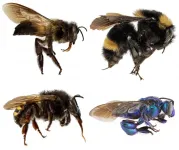(Press-News.org) DURHAM, N.H.--Researchers at the University of New Hampshire have conducted two of the first studies in New England to collectively show that toxic man-made chemicals called PFAS (per-and polyfluoroalkyl substances), found in everything from rugs to product packaging, end up in the environment differently after being processed through wastewater treatment facilities--making it more challenging to set acceptable screening levels.
"PFAS are persistent substances that are not easily broken down and have been linked to adverse health effects," said Paula Mouser, associate professor of civil and environmental engineering. "They are found in a wide variety of industrial, commercial and medicinal products and can end up in the body, human waste and the environment. If not managed correctly, they can be further distributed around the environment in landfills, waterways and even stabilized biosolids could be applied to agricultural fields as fertilizers."
The researchers looked at the journey of 24 different PFAS through six New Hampshire wastewater treatment facilities, including those along the Great Bay Estuary near the N.H. Seacoast, to examine how they are distributed after being treated. PFAS come in two forms, long-chain and short-chain, which refers to the number of carbon atoms attached to fluorine in the compounds. In their first study, recently published in the journal Environmental Science: Processes and Impacts, the researchers found that short-chain PFAS ended up in the facility liquid, or effluent, while long-chain PFAS were more abundant in the sludge due to their higher affinity toward solids.
After going through a range of biological and disinfectant processes in the municipal wastewater treatment facilities, researchers found roughly 10% of the PFAS present in Great Bay could be traced back to the wastewater facilities. This suggests other dominant PFAS sources are contributing to the waterways like septic systems, agricultural land and urban runoff (which can contain biosolids), groundwater discharge from contaminated sites and surface water runoff.
Currently, the United States Environmental Protection Agency (EPA) has only issued a drinking water health advisory for two of the 4,700 known PFAS, so individual states are working to set their own standards for PFAS in drinking water, surface water and biosolids. In 2020, the New Hampshire Department of Environmental Services established maximum contaminant levels (MCLs) for four PFAS in drinking water, while in 2019, the Maine Department of Environmental Protection (DEP) established screening levels for three PFAS in biosolids.
In the UNH researchers' second study, featured in the New England Water Environment Association Journal, the researchers used Maine's screening levels to look at both PFAS and PPCPs, pharmaceutical and personal care products like antibiotics and flame retardants, in biosolids from wastewater treatment facilities in both New Hampshire and Vermont. Of the 39 biosolids reviewed in the sludge waste, 29 had PFAS levels that exceeded screening levels set by the Maine DEP.
"State agencies across New England are all considering regulating PFAS in wastewater biosolids, but there is still more we need to know about how the treatment of wastewater sludge influences these forever chemicals," said Mouser.
The researchers say the challenge is finding a safe and acceptable level for waste residue that doesn't force facilities to deposit these solids in landfills which would be enormously costly, fill up landfills faster than anticipated and possibly lead to the leaching of PFAS into landfill wastewater that may continue the cycle by returning the not easily broken-down chemicals right back to treatment facilities.
The researchers say the studies highlight the knowledge gaps around contaminants of emerging concern, like PFAS, in wastewater residuals and stress that more research is needed to look at the influence of the facility design and operation on their treatment before costly upgrades are implemented in wastewater treatment facilities.
This research was funded by New Hampshire Sea Grant and the UNH Collaborative Research Excellence (CoRE) Initiative.
The University of New Hampshire inspires innovation and transforms lives in our state, nation, and world. More than 16,000 students from all 50 states and 71 countries engage with an award-winning faculty in top-ranked programs in business, engineering, law, health and human services, liberal arts and the sciences across more than 200 programs of study. As one of the nation's highest-performing research universities, UNH partners with NASA, NOAA, NSF and NIH, and receives more than $110 million in competitive external funding every year to further explore and define the frontiers of land, sea and space.
PHOTOS FOR DOWNLOAD
Image: https://www.unh.edu/unhtoday/sites/default/files/media/pfas_sampling_at_great_bay.jpg
Credit: UNH
Caption: UNH researchers sampling emerging contaminant in the Great Bay Estuary.
Image: https://www.unh.edu/unhtoday/sites/default/files/media/pfas_sampling_at_great_bay_from_boat.jpg
Credit: UNH
Caption: UNH researcher collecting samples of emerging contaminant in the Great Bay Estuary.
Image: https://www.unh.edu/unhtoday/sites/default/files/media/pfas_samples_3.jpg
Credit: UNH
Caption: Samples to be tested for traces of PFAS from one of six New Hampshire wastewater treatment facilities.
Image: https://www.unh.edu/unhtoday/sites/default/files/media/picture1_0.jpg
Credit: UNH
Caption: UNH master's students Elham Tavasoli, Alexandria Hidrovo and Chris Rodriquez sampling emerging contaminants at a New Hampshire wastewater treatment facility.
UNH research: Journey of PFAS in wastewater facilities highlights regulation challenges
2021-05-26
ELSE PRESS RELEASES FROM THIS DATE:
HKUST's meta-analysis shows SARS-CoV-2 variants unlikely to affect T cell responses
2021-05-26
In a new study, scientists at The Hong Kong University of Science and Technology (HKUST) have revealed that most T cell epitopes known to be targeted upon natural infection are seemingly unaffected by current SARS-CoV-2 variants.
In their latest research, the team compiled and analysed data from 18 immunological studies of T cell responses involving over 850 recovered COVID-19 patients from across four continents who are well-distributed in age, gender, disease severity and blood collection time. They demonstrated that T cells in these patients targeted fragments (epitopes) of almost all of ...
Study: Don't count on caffeine to fight sleep deprivation
2021-05-26
Rough night of sleep? Relying on caffeine to get you through the day isn't always the answer, says a new study from Michigan State University.
Researchers from MSU's Sleep and Learning Lab, led by psychology associate professor Kimberly Fenn, assessed how effective caffeine was in counteracting the negative effects of sleep deprivation on cognition. As it turns out, caffeine can only get you so far.
The study -- published in the most recent edition of Journal of Experimental Psychology: Learning, Memory, & Cognition -- assessed the impact of caffeine after a night of sleep deprivation. More than 275 participants were asked to complete a ...
Ultrafast, on-chip PCR could speed diagnosis during current and future pandemics
2021-05-26
Reverse transcription-polymerase chain reaction (RT-PCR) has been the gold standard for diagnosis during the COVID-19 pandemic. However, the PCR portion of the test requires bulky, expensive machines and takes about an hour to complete, making it difficult to quickly diagnose someone at a testing site. Now, researchers reporting in ACS Nano have developed a plasmofluidic chip that can perform PCR in only about 8 minutes, which could speed diagnosis during current and future pandemics.
Rapid diagnosis of COVID-19 and other highly contagious viral diseases is important for timely medical care, quarantining ...
Young adults with schizophrenia have highest suicide risk
2021-05-26
Adults with schizophrenia have an elevated risk of dying from suicide. Yet there's only limited understanding of when and why people with schizophrenia die of suicide --in part because research studies have looked at relatively small groups of patients.
Now a new study from Columbia that looked at a large population of adults diagnosed with schizophrenia has found the youngest group (18-34) had the highest suicide risk and those aged 65 and older had the lowest. By comparison, in the general U.S. population, younger adults have less risk and older age groups have greater risk.
The Columbia study, published online May 26 in the journal JAMA Psychiatry, (LINK TK) also showed that people with schizophrenia, overall, have a 4.5-fold increased risk of dying from suicide, ...
How the mold influences a chocolate bar's crystalline structure
2021-05-26
When enjoying a chocolate bar, most people don't think about how the molecules within it are organized. But different arrangements of the fats in chocolate can influence its taste and texture. Now, researchers reporting in ACS' Crystal Growth & Design have found that the side of a chocolate bar facing the mold has a more orderly crystalline structure than the side facing air, knowledge that might help chocolatiers produce tastier confections, the researchers say.
Chocolate is a mixture of cocoa solids, cocoa butter, sugar and other ingredients that interact with each other in complex ways. In particular, the fat molecules, or triacylglycerols, can remain liquid or crystallize into several phases with different melting points. ...
Research identifies climate-change refugia in dry-forest region
2021-05-26
Several indicators point to the adverse impacts of climate change on the planet’s vegetation, but a little-known positive fact is the existence of climate-change refugia in which trees are far less affected by the gradual rise in temperatures and changing rainfall regimes. Climate-change refugia are areas that are relatively buffered from climate change, such as wetlands, land bordering water courses, rocky outcrops, and valleys with cold-air pools or inversions, for example.
A study conducted in Peruaçu Caves National Park in the state of Minas Gerais, Brazil, with FAPESP’s support, confirmed and quantified ...
Slope stability model can help predict landslides to protect communities and save lives
2021-05-26
A mathematical model which can predict landslides that occur unexpectantly has been developed by two University of Melbourne scientists, with colleagues from GroundProbe-Orica and the University of Florence.
Professors Antoinette Tordesillas and Robin Batterham led the work over five years to develop and test the model SSSAFE (Spatiotemporal Slope Stability Analytics for Failure Estimation), which analyses slope stability over time to predict where and when a landslide or avalanche is likely to occur.
In a study published in Scientific Reports, ...
New research deepens mystery about evolution of bees' social behavior
2021-05-26
Annapolis, MD; May 26, 2021--A new study has mounted perhaps the most intricate, detailed look ever at the diversity in structure and form of bees, offering new insights in a long-standing debate over how complex social behaviors arose in certain branches of bees' evolutionary tree.
Published today in Insect Systematics and Diversity, the report is built on an analysis of nearly 300 morphological traits in bees, how those traits vary across numerous species, and what the variations suggest about the evolutionary relations between bee species. The result offers strong evidence that complex social behavior developed just once in pollen-carrying bees, rather than twice or more, separately, in different evolutionary branches--but ...
Scent trails could boost elephant conservation
2021-05-26
Travelling elephants pay close attention to scent trails of dung and urine left by other elephants, new research shows.
Scientists monitored well-used pathways and found that wild African savannah elephants - especially those travelling alone - were "highly attentive", sniffing and tracking the trail with their trunks.
This suggests these scents act as a "public information resource", according to researchers from the University of Exeter and Elephants for Africa.
More research is now needed to find out whether humans can create artificial elephant trails to divert elephants away from farms and villages, where conflict with humans can cause devastation to communities.
Alternatively, scent trails could be placed to improve the efficiency of routes ...
Glioblastoma study discovers protective role of metabolic enzyme, revealing a novel therapeutic target
2021-05-26
HOUSTON - Researchers at The University of Texas MD Anderson Cancer Center have discovered a novel function for the metabolic enzyme medium-chain acyl-CoA dehydrogenase (MCAD) in glioblastoma (GBM). MCAD prevents toxic lipid buildup, in addition to its normal role in energy production, so targeting MCAD causes irreversible damage and cell death specifically in cancer cells.
The study was published today in Cancer Discovery, a journal of the American Association for Cancer Research. Preclinical findings reveal an important new understanding of metabolism in GBM and support the development of MCAD inhibitors as a novel treatment strategy. The researchers currently are working to develop targeted therapies against the enzyme.
"With ...






